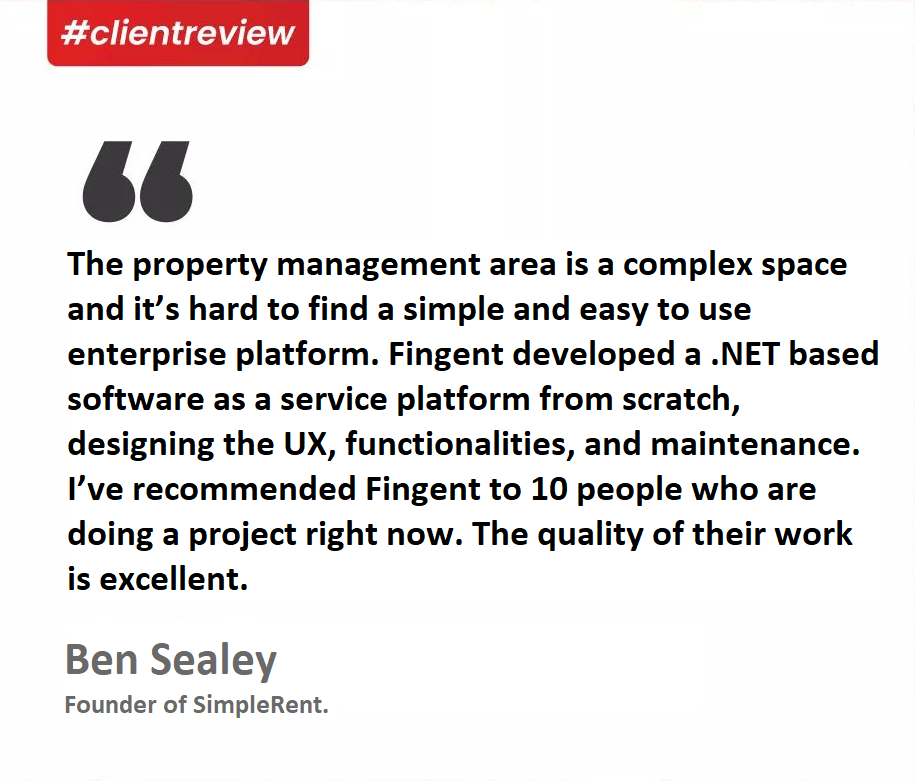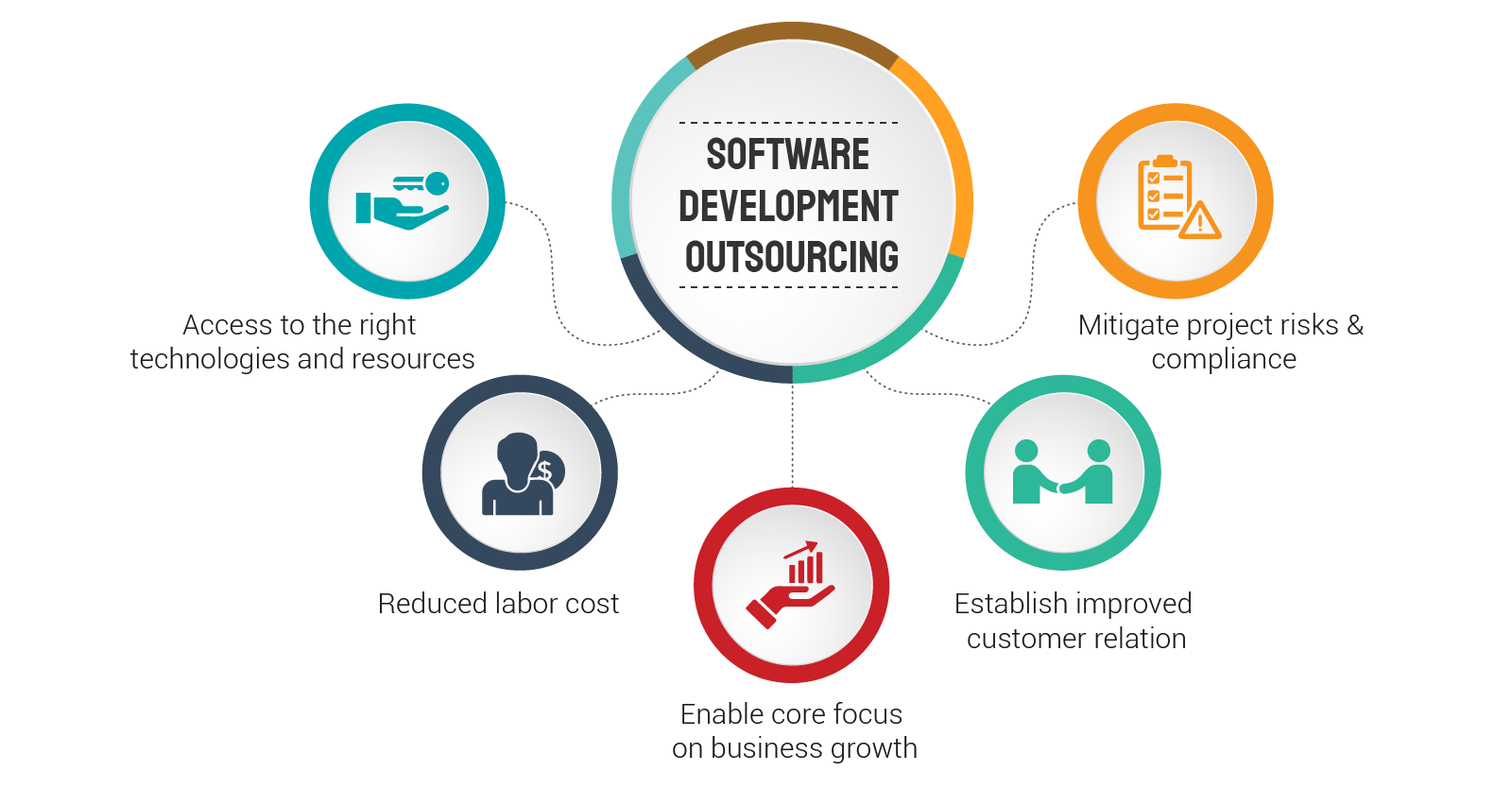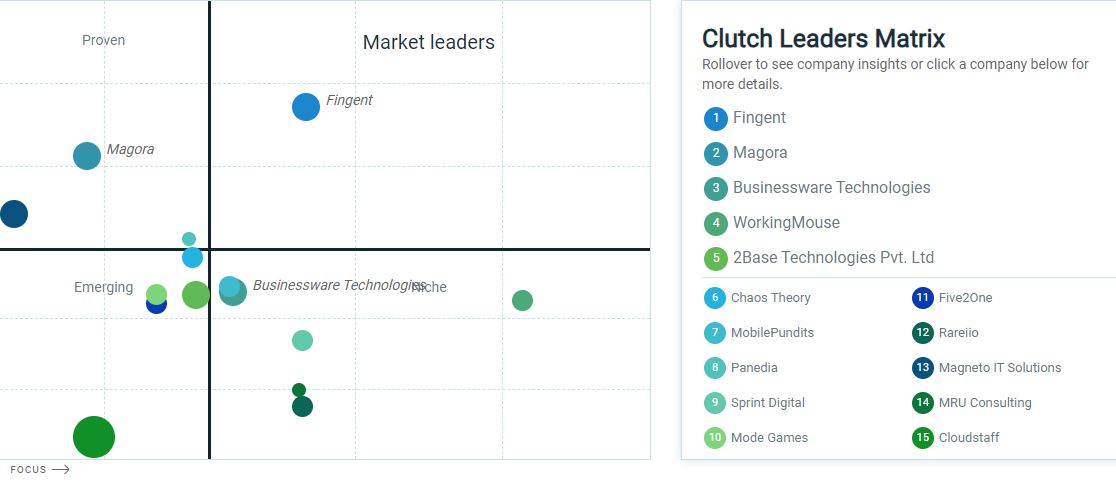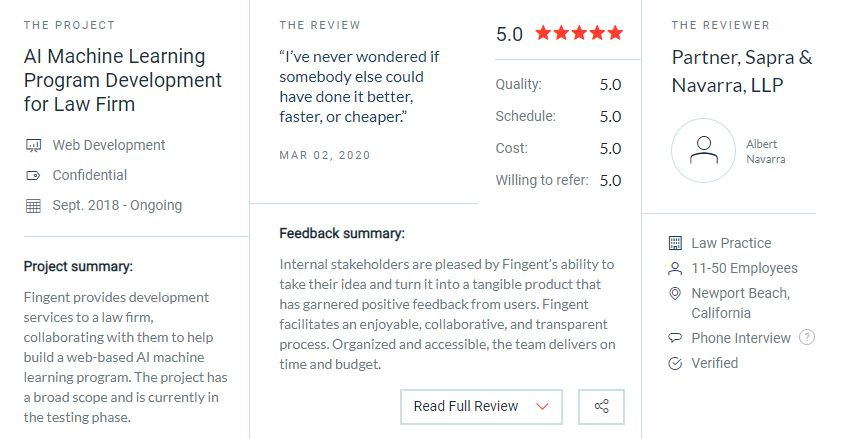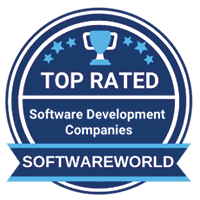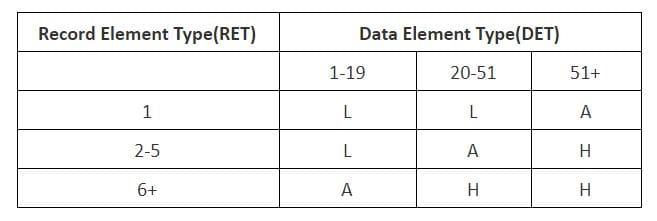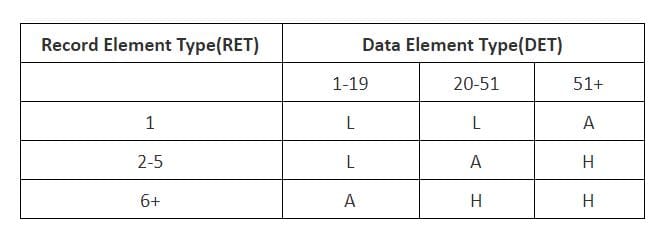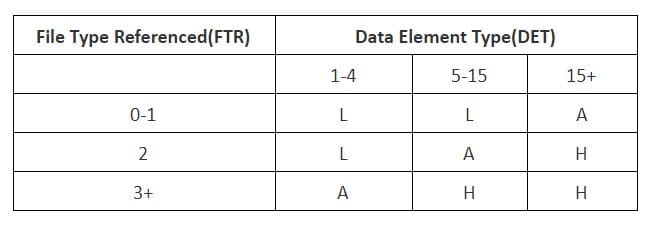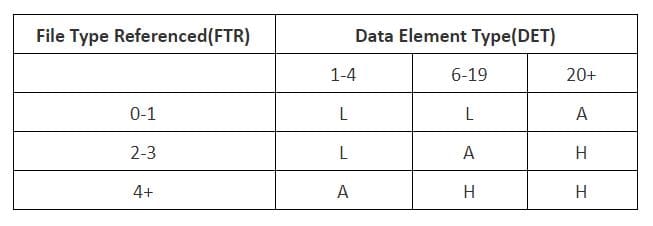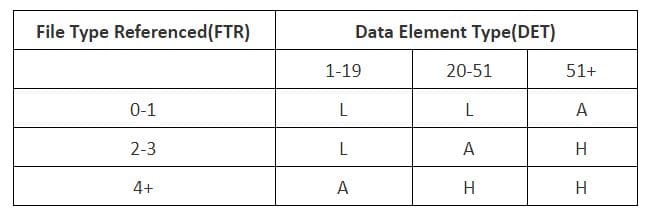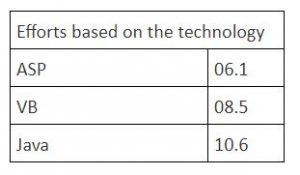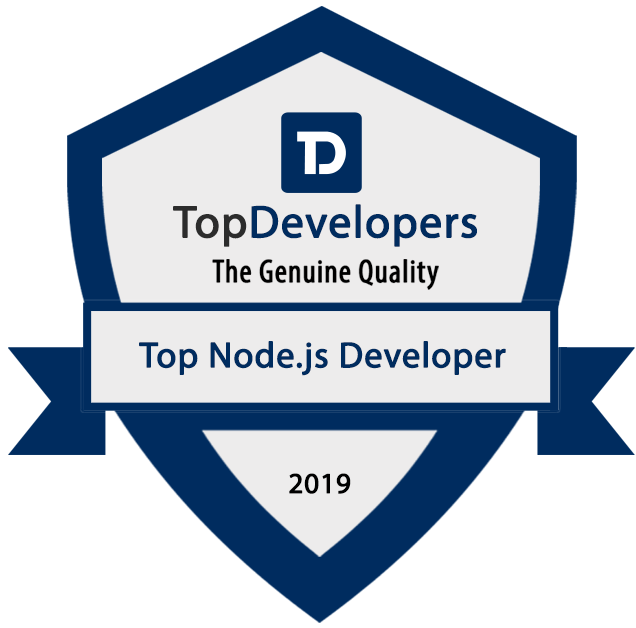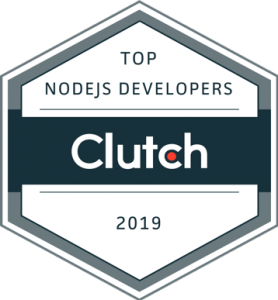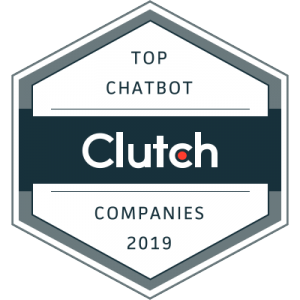Category: Enterprise Software
Top 5 benefits of outsourcing software development services
Software development outsourcing is empowering companies worldwide, including the most successful ones across their journeys. Leading players like Google, WhatsApp, Slack, and Microsoft have ample stories to share on their victorious feats with outsourcing development.
A study by Technavio reveals that the global IT outsourcing market will flourish at a CAGR of 5% during the period 2020-2024. The demand for outsourcing software development services keeps surging as organizations want to optimize their business processes and align their strategic planning with their operational strategies.
Outsourcing your IT necessities can be a boon in times of financial and natural adversities because outsourcing companies like Fingent implement business continuity planning and disaster recovery plans to fulfill obligations and deliver services without interruption.
If your company’s growth is dependent on software, and if you cannot afford your in-house IT team to divert from their core operations, it’s high time to outsource your software development needs.
Why software outsourcing is good for your business?
Facts and testimonies speak the truth!
More and more businesses today are relying on software outsourcing companies to develop their projects. Working with an outsourcing company will help you mitigate the risks of running a project internally. Outsourcing can compensate for a lack of in-house skills and ensures that your product is delivered on time.
At Fingent, we specialize as an offshore software development company. Many of our customers have shared their outsourcing success stories with us. A .NET based SaaS platform developed by Fingent has played a great role in the growth of the property management undertaking – SimpleRent. Here’s what SimpleRent’s founder told us.
PwC, one of our prominent customers, reports an 80% increase in productivity and a 67% faster ticket resolution rate after Fingent helped them implement a smart ticketing system. Thanks to outsourcing!
As an outsourcing development company, here are a few reasons why we think outsourcing makes your business more efficient and smarter.
Related Reading: Points to Consider Before Choosing the Best Software Development Company
1. Access to the finest talent and latest technology
Software development outsourcing helps in finding the right talents and minimizing your human-resource problems. If your country has a limited talent pool, outsourcing gives you access to a wider talent pool available anywhere on the globe.
Technology keeps evolving every day and your business needs to take advantage of its benefits. With outsourcing, you will gain access to new and innovative perspectives and an opportunity to utilize strong and diverse technology expertise.
2. Outsourcing cuts down your costs
The biggest benefit of offshore software development undoubtedly is the cost savings. Outsourcing software development companies do not necessarily demand you to make any upfront investments. By contracting work to other companies, you can cut down 70-90% of your labor costs, all while paying your outsourced workforce at competent rates. The cost advantages make your development project more attractive and reduce your overall workload.
Adopting a cost-effective engagement model is crucial to the success of outsourcing. We help you choose the right engagement model essential for the creation of your state-of-the-art product.
3. Improved flexibility and time management
When you outsource your work, you don’t have to spend time hiring and training resources. At Fingent, we take care of all the change requirements even when the project sizes vary or resource-related demands scale up.
Outsourcing software development services accelerate your time-to-market. With people working around the clock, your competitiveness improves greatly and gives you an edge over your competitors.
4. Take your business to the next level with a focused strategy
To win the technological race, you need to have a focused strategy. Every business needs to align its operational strategy with the changing people, process, and technology. When your software is developed by an outsourcing company, your business processes will be highly streamlined and optimized, allowing you to focus on the core activities that will take your business to the next level.
5. Managing risks and compliance
Partnering with a software outsourcing company like Fingent enables you to mitigate the risks associated with handling your project. We follow a high-quality project management system that has been tried, tested and proven across our past as well as ongoing projects.
While outsourcing your software development needs, you are setting out to work with a global talent pool. We take care of all the legal compliance-related matters that have to be fulfilled while onboarding offshore resources as well as forging contracts with our clients. This lets you focus on other things that matter.
Related Reading: The Pros and Cons of Outsourcing Mobile App Development
Ready to outsource your software development needs?
From resource hiring and onboarding to management training and payroll software, several functions can be outsourced by a company. In the age of globalization and technological competition, software development outsourcing is the key to your success. Share your queries and concerns about outsourcing with us. Our consultants can walk you through the best and most affordable solution that works for you.
Re-Engineer your Business Processes with Superior Solutions Now!
Stay up to date on what's new

Featured Blogs
Stay up to date on
what's new



Talk To Our Experts
How DevOps Uses Test Automation Tools to Accelerate Software Development
The goal of DevOps is to build faster, effective, and responsive applications by bringing together the development team and the operations team. It is a cultural shift to remove all barriers between Dev and Ops and provide shorter as well as frequent software deliveries, thus enabling organizations to respond in a much agile manner with respect to the constantly changing customer demands and expectations.
In a nutshell, DevOps via effective collaboration, communication, streamlined delivery, and automation of processes will accelerate software development in the following key ways:
- Faster time to market
- Reduces risks of failures in each release
- Enhances error fixing and recovery time
- Improves the checking process efficiency
- Speeds up the rate of change
- Allows managers to make improved and effective trade-off decisions
- Enables rapid and continuous feedback
- Offers flawless continuity throughout the Software Development Lifecycle
Testing in DevOps starts from the very beginning of application development and hence it is important to make sure that the development team and the operations team work closely with each other to ensure continuous integration and prompt delivery by continuous testing and monitoring.
Related Reading: Test Automation Trends to Accelerate Development Cycles in 2020
Automation Testing in a DevOps Environment
DevOps is categorized into the following 4 processes:
- Continuous Integration
- Continuous Delivery
- Continuous Testing
- Continuous Monitoring
The testing teams require to align their test design, automation, as well as test case development along with DevOps to ensure that the frequent changes made have not affected the final product.
Unlike the traditional approach, automation testing in a DevOps environment requires moving test automation scripts to a control tool which is of an enterprise version. This system of centralized enterprise-level testing results in an integrated test suite that offers centralized execution and reporting.
Let us walk through the different ways in which DevOps makes use of test automation tools:
How DevOps Uses Test Automation to Speed Up Software Development and Delivery
DevOps testing lays its core focus on test automation within the application’s development pipeline to ensure that by the time the application is deployable, it is done without any further confusion. Some of the popular test automation tools of DevOps are Selenium and Water.
Here is a quick rundown on the popular DevOps tools:
1. New Relic– New Relic offers an end to end visibility along with improved customer experience and dynamic infrastructure. It also helps the DevOps team to save their time spent in monitoring applications.
2. Jenkins – Jenkins is a DevOps automation tool used for checking the execution of redundant tasks. Jenkins is an open-source CI/CD (Continuous Integration/ Continuous Delivery) server that allows users to automate various phases involved in the application delivery pipeline.
3. Splunk – This automation tool is used to access machine data. It offers operational effectiveness to both the development as well as the operations teams in DevOps. It offers enterprises the ability to be more productive, competitive, secure, and reliable.
4. Selenium – Being the most popular automation testing tool for DevOps, Selenium is designed to meet the specific needs of a wide range of different browsers. It makes use of lesser resources and supports parallel test execution which reduces the overall time required for the testing process. The test cases prepared can be run on any operating system as well.
Cucumber, Jasmine, JUnit, and JMeter are other popular test automation tools used by DevOps to accelerate application development and deployment.
Related Reading: How To Measure The Effectiveness Of Your DevOps Program
Future of Test Automation in DevOps: Enhancing Application Development
With the evolution of continuous testing, DevOps has enhanced its test automation strategies where it is supported by practices such as a test-case design that is risk-based, stateful test data management, service virtualization, as well as seamless integration into the DevOps set of test automation tools.
To get the best out of test automation and to learn how to incorporate test automation tools using DevOps to accelerate your application development and deployment, talk to our experts today.
Stay up to date on what's new

Featured Blogs
Stay up to date on
what's new



Talk To Our Experts
Why Clutch Ranks Fingent As The Top Software Development Company In Australia?
Over the past 16 years, Fingent has partnered with clients across 4 continents and collaborated with start-up, mid-market, and large enterprises to solve business challenges with the latest custom software development practices. Our core values make us highly attentive to society, peers, family & self, and above all, customers. We are grateful that this client focus is recognized in reviews on Clutch and has enabled us to achieve the position of the leading software developer in Australia.
Clutch is a B2B rating and review platform with thousands of company profiles. Clutch carefully analyzes and evaluates industry data, brand reputation, and most importantly, client testimonials to craft authentic descriptions of development companies and their services. When a company is facing a business challenge, Clutch stands as a directory to browse through and find the right solution provider. Clutch connects businesses with leading performers, who receive industry recognition for their excellent services. When it comes to software development, Fingent ranks as the Top Software Developer in Australia. Here’s a peek into Clutch’s leader matrix, where Fingent stands top on the charts of Market Leaders in comparison to the competing companies.
We are extremely thankful to the clients who took the time to share their experiences about Fingent solutions and services on Clutch. Most recently, Sapra & Navarra LLP left us a review on our ongoing development services for their law firm. We were hired by Sapra & Navarra LLP to build a web-based AI machine learning program. Besides receiving 5.0 stars in the Clutch evaluation categories of cost, scheduling, quality, and willingness to refer, Sapra & Navarra LLP appreciated our accessibility and efforts to prioritize being available to answer any questions or concerns. They also applauded our organization, including our robust agendas of maintaining transparency through meetings and conference calls.
Check out a summary of the perfect 5.0 review below!
Once again, we are very grateful to our clients for sharing their positive feedback on Clutch. It inspires us to continue delivering unique, budget-friendly solutions on time.
“We are excited to have been chosen as a top ASP.NET developer and NodeJS developer for 2020 by Clutch.”
– Stephen Cummings, Senior Vice President – Business Development, Fingent
If you’re looking for a technology partner who can build a web or mobile app, deploy RPA or AI technology, or provide software consulting, please get in touch! We’d love to discuss your latest project.
Stay up to date on what's new

Featured Blogs
Stay up to date on
what's new



Talk To Our Experts
How AI is bringing change to the software testing practice
Artificial Intelligence is penetrating into multiple functions performed by the software industry. In software testing, the technology holds the potential to be a game-changer. Imagine the capability of your software to test and diagnose itself and make self-corrections! This will lead to huge savings on your resources. With this in mind, let’s try and understand exactly how AI will impact the traditional way of software testing.
Before we proceed, let’s get one thing clear – Do we really need AI in software testing?
Do We Really Need AI in Software Testing?
Software testing came into existence as a result of the evolution of development methodologies. It fed the need for robust, error-free software products. Testing was a laborious task for sure. However, automating software testing required traceability and versioning, both of which were critical and needed careful consideration. Something was needed to resolve this.
As businesses move towards digital transformation and the software market continues to grow, businesses expect a real-time risk assessment across all stages of the software delivery cycle. AI in software testing is the right response to these challenges. AI can develop error-free applications while enabling greater automation in software testing. This helps meet the expanded, critical demands for testing. It improves the quality of engineering and reduces testing time allowing the tester to focus on more important things. The verdict is clear then – We Really Need AI for Software Testing!
Five Impressive Ways AI Impacts Software Testing
1. Improves object application categorization
AI is widely used in object application categorization. When tools and testers are created, unique pre-train controls can be created. Once the hierarchy of the controls is categorized, testers can create a technical map to obtain labels for the different controls.
In the near future, AI will become capable of observing users perform exploratory testing on the testing site. And once user behavior is assessed, it can assign, monitor, and categorize the risk preference.
2. Automation of test case writing
Gone are the days of web crawlers. As automation is picking momentum, AI tools have become capable of learning business usage scenarios of test applications.
Related Reading: Unconventional Ways Artificial Intelligence Drives Business Value
They can automatically collect insightful data such as HTML pages, screenshots and page loading time and eventually train ML models for expected patterns of the app. And as soon as they are executed, any variations are marked as potential issues. This makes it easier for the tester to find and validate differences and fix issues.
3. Enhanced accuracy
To date, source analysis requires human resources to accomplish the task. Unfortunately, because of the enormity of the data, even the best experts could overlook, or miss out on observing certain critical defects. Human error and the tendency to lose focus further impairs the experts involved in software testing. It can be disastrous if bugs caused by these errors are caught by consumers before project stakeholders. Product positioning and brand reputation can be jeopardized.
Thankfully, AI can teach systems to learn source analysis and, in the future, apply this acquired knowledge. This ensures that testers have greatly enhanced accuracy. It eliminates the probability of human error and also shortens the time to run a test and increases the possibility of finding defects or bugs.
4. Automation without the user interface
AI-based techniques can be applied for non-functional tests such as performance, security and unit integration. It can also be applied on various application logs which assists in developing auto-scaling capabilities such as bug prediction.
AI algorithms can enhance UI testing, predict the next test, determine the outcomes for subjective and complex tests and much more. In other words, AI could increase the overall test coverage while it increases the depth and scope of the test itself.
5. Reduces cost and decreases time to market
The need for manually repeating a test is time-consuming and extremely expensive. But with AI, such tests can be automated to repeat several times over. Each time the software test is repeated automatically, the source code gets modified to correct any bugs. This eliminates the additional cost of repeating the test and increases the speed of the test from days to hours, which in turn saves more money.
Related Reading: Quality Assurance in Software Testing – Past, Present & Future
Allow AI to Revolutionize your Business
AI has proven to have a significant impact on software testing with its benefits ranging from optimization to extraordinary savings. It enables testers to move beyond the traditional route and dive toward precision-based testing processes. This can prove invaluable to your business. To find out how you can make this happen for your business, contact us.
Stay up to date on what's new

Featured Blogs
Stay up to date on
what's new



Talk To Our Experts
Fingent Receives High Praise from Leading Businesses Around The World!
In today’s increasingly digital marketplace, technology is key to gaining a competitive advantage. Of course, with technology advancing at an unprecedented rate, determining how to most effectively deploy the latest technologies is easier said than done. As a top custom software development company, we build high-quality, cost-effective web and mobile solutions that deploy the newest technologies and meet all of your enterprise needs.
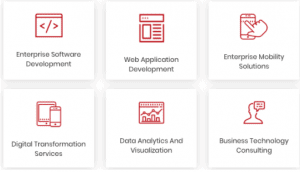
We’re committed to delivering the best quality and customer service — and for that reason, we’re a trusted partner to some of the world’s leading enterprises and businesses.
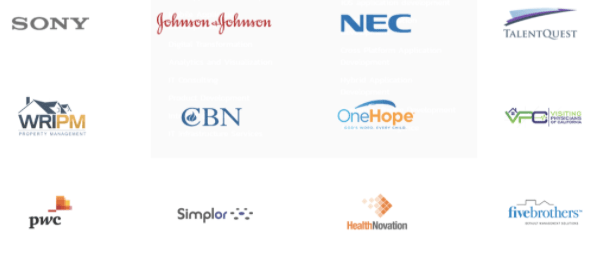
We know how important it is for potential buyers to peruse client testimonials and understand what it’s like to work with us before signing a contract, and that’s why we’ve partnered with the ratings and reviews platform Clutch.
Of more than 300 firms, Clutch ranks us among the top 3 software developers in NY! Clutch determines industry leaders based on market research and client feedback, so we’re immensely grateful to the clients who have left reviews for us. One of our recent reviews was from Wage CALC, a company that provides attorneys and legal professionals with a better way to manage their wage and hour cases with wage & analysis software.
Wage CALC was in need of custom software development services. They were looking for a trustworthy, well-known developer — and they found us on Clutch! Deploying a Microsoft Excel prototype that they’d created, we built their cloud-based app from the ground up.
“I’ve had such an excellent experience with them. Fingent exceeded my expectations.” — Founder & CEO, Wage CALC
The client was impressed that we were able to break down their complex, formula-heavy prototype. They commended our professional and responsive team and were particularly appreciative of how our SVP helped to streamline communication between our team in India and theirs in California.
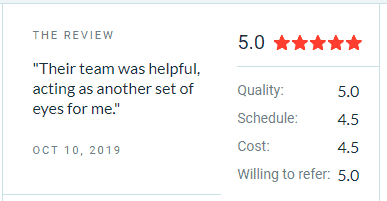
We received another 5-star review from a large transportation and logistics company that specializes in oil and gas equipment pickup and delivery. There’s a significant technology gap when it comes to processing orders, invoicing, and workflow management within the logistics industry, and we were prepared to change that.
We developed an end-to-end transportation management solution. The solution allows customer service representatives to assign vehicles for order pickup and delivery, while drivers can use a mobile version of the solution to send documentation and process tickets and billing. The company’s accounting team also uses the system to do invoicing, collect payments, and close orders.
“The management system is light years ahead of anything else in our industry.” — IT Director, Transporation Company
The client appreciated our consistency and availability, along with our team’s impressive knowledge and talent.
Meanwhile, The Manifest, Clutch’s partner site listing market experts, ranks us as the #1 custom software development company.
Fingent is not just recognized by the Clutch! A few well-known rating sites like the Software World, have also appreciated Fingent for its expertise in software development and technology solutions.
Learn more on why Fingent is the most trusted Tech Partner for emerging enterprises, and how our expertise can benefit your business. Contact us today — we offer free consultations!
Stay up to date on what's new

Featured Blogs
Stay up to date on
what's new



Talk To Our Experts
Turning The Year Of Multi-Cloud Adoption for Enterprises
There has been a lot of hype going on around businesses adopting multi-cloud strategies that make use of public, private, and hybrid cloud services. Businesses, especially the mid-market and enterprise-level industries can utilize multi-cloud strategy as a smart investment by leveraging the benefits of its resilient performance and virtual infrastructure.
A multi-cloud strategy is all about adopting a mixture of IAAS (Infrastructure As A Service) services from multiple cloud providers and sharing workloads among each of these services which are reliable, secure, flexible, and of course cost-effective.
Why Must Businesses Opt For A Multi-Cloud Strategy?
Businesses can adopt a multi-cloud strategy to acquire an optimal distribution of assets across the user’s cloud-hosting environments. With a multi-cloud strategy, businesses can have access to multiple options such as favorable Service Level Agreement terms and conditions, greater upload speed selection, customizable capacity, cost terms, and many more.
How Can Businesses Make A Multi-Cloud Adoption Decision?
Multi-cloud adoption decisions are based on 3 major considerations:
- Sourcing – Agility can be improved and chances of vendor lock-in can be avoided or minimized by sourcing. This decision can be driven by factors such as performance, data sovereignty, availability, regulatory requirements, and so on.
- Architecture – Architecture is a major decision-driver as many modern applications are mostly of modular fashion that can span multiple cloud providers and obtain services from any number of clouds.
- Governance – Businesses can now standardize policies, procedures, processes, and even share tools that can enable cost governance. By adopting services from multiple cloud providers, enterprises can now ensure operational control, unify administrative processes, and monitor their IT systems more effectively and efficiently.
Better disaster recovery and easier migration are the other key benefits that drive enterprises to adopt multi-cloud strategies.
Related Reading: Cloud Computing Trends To Expect In 2020
Top 7 Reasons To Adopt Multi-Cloud For Your Business
-
Ability To Find The Best-In-Class Multi-Cloud Providers
Businesses administrators can bring in the best-in-class cloud hosting providers for each task that best suits their requirements. In a recent survey by Gartner, 81% of respondents said that the multi-cloud approach proved beneficial to them. Businesses are free to make their decisions based on the sourcing, architecture, and governance factors as mentioned above.
-
Agility
According to a recent study by RightScale, organizations leverage almost 5 different cloud platforms on average. This figure shows the transformation of enterprises increasingly towards multi-cloud environments. Businesses struggling with legacy IT systems, hardware suppliers, and on-premise structures can benefit from adopting multi-cloud infrastructures to improve agility as well as workload mobility amongst heterogeneous cloud platforms.
-
Flexibility And Scalability
With a competent multi-cloud adoption, enterprises can now scale their storage up or down based on their requirements. A multi-cloud environment is a perfect place for the storage of data with proper automation as well as real-time syncing. Based on the requirements of individual data segments, businesses can depend on multiple cloud vendors specifically. For improved scalability, enterprises must focus on achieving the following 4 key factors:
- A single view of each cloud asset
- Portable application design
- The capability to automate and orchestrate across multiple clouds
- Improved workload placement
-
Network Performance Improvement
With a multi-cloud interconnection, enterprises can now create high-speed, low-latency infrastructures. This helps to reduce the costs associated with integrating clouds with the existing IT system. When businesses extend their networks to multiple providers in this manner, proximity is ensured and low-latency connections are established that in turn improves the application’s response time along with providing the user a better experience.
-
Improved Risk Management
Risk management is a great advantage that multi-cloud strategies can provide businesses with. For instance, consider the case where a vendor has an infrastructure meltdown or an attack. A multi-cloud user can mitigate the risk by switching to another service provider or back up or to a private cloud, immediately. Adopting redundant, independent systems that provide robust authentication features, vulnerability testing as well as API assets consolidation ensure proper risk management.
-
Prevention Of Vendor Lock-In
With a multi-cloud strategy, enterprises can evaluate the benefits, terms, and pitfalls of multiple service providers and can choose the option to switch to another vendor after negotiation and careful validation. Analyzing terms and conditions before signing a partnership with a vendor can prevent vendor lock-in situations.
-
Competitive Pricing
Enterprises can choose between the vendors and select the best-suited based on their offerings such as adjustable contracts, flexible payment schemes, the capacity to customize, and many other features.
To learn more about adopting an effective multi-cloud strategy and the benefits it offers, drop us a call and talk to an expert.
Stay up to date on what's new

Featured Blogs
Stay up to date on
what's new



Talk To Our Experts
Every new project in an organization goes through an analysis phase. The information collected during the analysis forms the backbone for critical decisions with regards to the complexity, resources, frameworks, time schedule, cost, etc. Over the years, there have been several techniques to simplify the project analysis phase, but most of them still remain inadequate when considering the accuracy of the outcome. Even clearly defined projects can fall out during the later stages without an accurate analysis methodology in place.
Mitigation of risk in software projects turns out to be of prime importance. Usually, it starts with delineating precise measurements concerning the scope, performance, duration, quality and other key efficiency metrics of the project. Advanced analysis techniques like Function Point Analysis (FPA) bring a clear picture regarding each of these metrics, chiefly related to the project scope, staffing, cost and time, which helps in the management, control, customization of software development right from its initial planning phases.
Function Point Analysis is a standardized method used commonly as an estimation technique in software engineering. First defined by Allan J. Albrecht in 1979 at IBM, Function Point Analysis, has since then underwent several modifications, mainly by the International Function Point Users Group (IFPUG).
What is Function Point Analysis?
In simple words, FPA is a technique used to measure software requirements based on the different functions that the requirement can be split into. Each function is assigned with some points based on the FPA rules and then these points are summarized using the FPA formula. The final figure shows the total man-hours required to achieve the complete requirement.
Components of Function Point Analysis
Based on the interaction of the system components internally and with external users, applications, etc they are categorized into five types:
- External Inputs (EI): This is the process of capturing inputs from users like control information or business information and store it as internal/external logic database files.
- External Outputs (EO): This is the process of sending out data to external users or systems. The data might be directly grabbed from database files or might undergo some system-level processing.
- Inquiries (EQ): This process includes both input and output components. The data is then processed to extract relevant information from internal/external database files.
- Internal Logic File (ILF): This is the set of data present within the system. The majority of the data will be interrelated and are captured via the inputs received from the external sources.
- External Logic File (ELF): This is the set of data from external resources or external applications. The majority of the data from the external resource is used by the system for reference purposes.
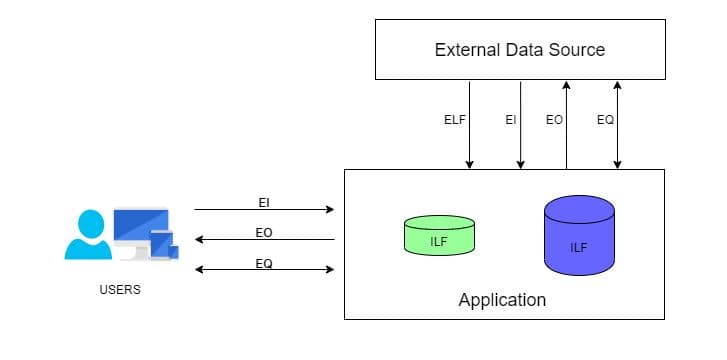
Below are some abbreviations which need to be understood to know the logic in-depth:
Data Element Type (DET): This can be defined as a single, unique, non-repetitive data field.
Record Element Type (RET): This can be defined as a group of DETs. In a more generic way, we can call this a table of data fields.
File Type Referenced (FTR): This can be defined as a file type referenced by a transaction (Input/Output/Inquiry). This can be either an Internal logic file or an external interface file.
Based on the number of DETs and RETs, all the five components of FPA are classified into High, Average and Low complexity based on the below table.
For Internal Logical Files
And based on the complexity, the FPA points are calculated
For External Logical Files
And based on the complexity, the FPA points are calculated
For External Input Transactions
As the External input is a Transactional type, the complexity is judged based on FTR instead of RET.
And based on the complexity, the FPA points are calculated
For External Output Transactions
As External Output is a Transactional type the complexity is judged based on FTR instead of RET.
And based on the complexity, the FPA points are calculated
For Inquiries
As Inquiries is a Transactional type the complexity is judged based on FTR instead of RET.
And based on the complexity, the FPA points are calculated
As we now have the reference chart to find the complexity of each variety of functions discovered in the system and that we also have the Points that should be assigned based on the complexity of each component. We can now look into the calculation.
Steps to Count the Function Points
Below are the steps used in counting the function points of a system.
1. Type of count: The very first step of this process is to determine the type of function count. There are 3 types of function point (FP) count.
- Development Project FP Count: This measures the functions that are directly involved in the development of the final system. This would include all the phases of the project from requirements gathering to the first installation.
- Enhancement Project FP Count: This measures the functions involved in the modifications brought in the system. That is the changes made to the system after production.
- Application FP count: This measures the functions involved in the final deliverable excluding the effort of already existing functions that may have existed.
2. Scope and Boundary of the Count: In the second step, the scope and boundary of the functions are identified. Boundary indicates the border between the application being measured and the external applications. Scope can be decided with the help of data screens, reports, and files.
3. Unadjusted Function Point Count: This is the main step of this process where all the function points produced from the above FPA components (External Inputs, External Output, Internal Logic files, External Logic files, Inquiries) are added together and labeled as unadjusted function point count.
4. Value Adjustment Factor: In this step the value adjustment factor is determined. VAF contains 14 General system characteristics(GSC) of the system or application that defines the types of application characteristics and is rated on a scale of 0 to 5. The sum of all the 14 GSC rates are calculated to give out a mathematical value and is labeled as Total Degree Influence(TDI). TDI is used in the calculation of VAF and its value may vary from 0 to 35.
Below are the 14 GSCs listed and the mathematical formula for calculating the VAF.
- Data communications
- Distributed data processing
- Performance
- Heavily used configuration
- Transaction rate
- On-Line data entry
- End-user efficiency
- On-Line update
- Complex processing
- Reusability
- Installation ease
- Operational ease
- Facilitate change
- Multiple sites
Once the unadjusted function point and value adjustment factor is calculated, the Adjusted Functional point count is found out using the two values. This is done with the help of the following formula.
The Adjusted FPC is then multiplied with a numeric value, which is the effort based on the technology. Some of the examples are below.
If the technology selected for a particular requirement is Java, then the formula to calculate the final hours are as follows:
FPC = (Non-adjusted FPC*VAF) * 10.6
This will give the total hours of effort required to achieve the requirement under analysis.
Merits of Function Point Analysis
- FPA measures the size of the solution instead of the size of the problem
- It helps in estimating overall project costs, schedule, and effort
- It is independent of technology/programming language
- It helps in the estimation of testing projects
- FPA gives clarity in contract negotiations as it provides a method of easier communication with business groups
Related Read: Quality Assurance in Software Testing – Past, Present & Future
References
- International Function Point User Group (IFPUG) – https://www.ifpug.org/
- ProfessionalQA.com – http://www.professionalqa.com/functional-point-analysis
- Geeksforgeeks – https://www.geeksforgeeks.org/software-engineering-functional-point-fp-analysis/
Stay up to date on what's new

Featured Blogs
Stay up to date on
what's new



Talk To Our Experts
Fingent Emerges as a Leader in Node.js Development
Fingent is proud to announce that we have been featured in a recent press release recognizing the top Node.js development companies by TopDevelopers.co, a renowned review and research platform of IT service providers.
The importance of Node.js
Node.js is a versatile server-side environment that lets the developer create powerful server-side applications with JavaScript. The availability of a large repository of codes, speed and the efficiency of Node.js are the factors that have contributed to the rising popularity of the platform.
About Fingent
Fingent was established in 2003 with an aim to provide custom software services to our clients. With determination, hard work and a constant focus on the requirements of our customers, we have expanded and today we are serving clients across more than 20 industrial sectors and have an active client base in more than 14 countries covering 4 continents.
With a curious mind and a constant zeal towards customer satisfaction, we have been able to achieve this milestone of entering the coveted list of top Node.js developers.
Why do clients consider Fingent as an efficient service provider?
We have been able to achieve a satisfactory rating of 4.9 out of 5 on the 650+ projects that we have completed. In all these years, we have never lost our focus on understanding the problems of the clients and offering innovative solutions to them. We have established a dedicated research and development center in India to focus on delivering innovative solutions to our customers.
More than 30 companies including brands such as Sony, NEC, PWC, and Johnson & Johnson have named us as their Global IT partners.
We provide a plethora of exclusive and efficient IT services to our clients which includes services like enterprise software development, hybrid app development, Internet of Things, IT consulting, product development services, mobile application development services, Artificial Intelligence, custom software development, cloud computing, iOS app development, and SAP.
We have happily worked with clients from a diverse set of industries like retail, logistics, real estate, oil and gas, healthcare, fitness, legal consultants, chemicals, to name a few, but we have never let them go without a smile of satisfaction after project delivery. Working with diverse industries and varied client requirements has helped us in learning the nuances of each industry, which has ultimately helped us in serving our clients in a better manner.
We helped a client in designing a solution that uses the data of NHS (National Health Service) in the United Kingdom as input and gives interactive visually rich graphs as output. The aim was to analyze the data and provide the users with a list of the best hospitals in the U.K. The solution we developed provides the users with every detail about the hospitals listed. Our portfolio has more details about NHS and a deep insight into our projects, work proficiency, technical product development skills, and professionalism.
“We take a holistic view, considering for instance – the role of the app in the larger ecosystem that may include AI, Big Data and IoT, whether it connects to 3rd party systems, and most importantly the desired Customer Experience across the entire customer journey.” is what our Senior Vice President – Process and Technology, Mr. Deepu Prakash, expressed in an interview with TopDevelopers.co.
The profile of Fingent on TopDevelopers.co has all the interesting details on how Fingent has successfully been maintaining a remarkable balance between the clients we cater to, the various industrial sectors we serve, and the wide range of services that we provide.
Who is TopDevelopers.co?
TopDevelopers.co is a directory and review platform for B2B IT Firms. They offer unbiased service to service seekers, by providing them a listing of genuine and highly professional IT firms, that can help the service seekers in achieving their goals by providing high-quality technical services. The research team of TopDevelopers.co chooses the best firms by filtering a vast list of companies and introduces only the competitive names to the businesses, enterprises, and entrepreneurs to partner with. The company has a friendly team of researchers and a hassle-free communication system. They provide the listing service for various technologies and services, which makes it a one-stop destination to find your perfect technology partner. To give its clients a broad range, TopDevelopers.co reviews companies from all across the globe and you can filter the companies according to the country of origin, size, cost and other parameters.
To know more about why Fingent is rated as the top Node.js development company by TopDevelopers.co and how our skills and expertise can bring your business the competitive advantage to excel, contact us!
Stay up to date on what's new

Featured Blogs
Stay up to date on
what's new



Talk To Our Experts
Clutch Yet Again Rates Fingent As The Top Custom Software Development Company
As a dominant software development company, Fingent sets the bar high in building highly affordable products for companies small and large. We’ve become the trusted partner in enterprise solutions for some of the world’s leading businesses like Johnson & Johnson, Sony, and PwC. Our work and our strong leadership in technologies like .Net, NodeJS, AngularJS, AI enabled Chatbots and Microsoft, has once again caught the attention of Clutch.co, as they recently recognized us as Australia’s top B2B company.
Clutch, is a B2B rating and review platform located in Washington, DC. In their latest report that we were named in, their dedicated analysts evaluated technology sub-services based on their expertise, their portfolio of work, and their ability to deliver top-notch products for their clients. Their independent review process is meticulous and transparent, and we’re especially grateful to our clients for taking the time to leave a review or speak with Clutch analysts over the phone to provide feedback.
[Tweet “Getting featured on Clutch consecutively and this time among Australia’s top B2B companies signify how our services have fared out remarkably well within the user community. @vsamuelfingent“] [Tweet “Surely, this puts further responsibility on our side to constantly improvise the solutions that we offer so that businesses that rely on our services are better off with efficiency improvements and deliver optimal customer experiences says @vsamuelfingent“]Fingent CEO and MD, Varghese Samuel
Beyond the generous reviews left on Clutch, our success is also reflected on the company’s sister-sites: Visual Objects and The Manifest. Visual Objects showcases portfolios from various creative software developers, to aid prospective clients in visualizing a future project before hiring. The Manifest also helps prospective clients, through industry reports and how-to guides, that provide businesses with practical knowledge of the services and technologies used by the B2B companies. Here, we are listed and recognized for our abilities in NodeJS and AngularJS.
Our constant approach in redefining business with trending technologies like Microsoft and Artificial Intelligence have enabled us to rank amongst the top-rated custom software developing companies in Clutch, Visual Objects, and The Manifest. We have repeatedly been appreciated and recognized for our capabilities in AI-driven Chatbots for enhanced user experience.
Our motive to shape the future of industries with enhanced, custom software solutions has led us to where we are today. On behalf of Fingent top custom software development company, we would like to thank all of our clients that we have had the pleasure to work with, and Clutch for this prestigious recognition.
If you would like to learn more about our services, check out our profile in Clutch.
Stay up to date on what's new

Featured Blogs
Stay up to date on
what's new



Talk To Our Experts
Despite the industry buzz over the past few years, benefits realization and simple operational stability after go-live are arguably the biggest challenges companies are facing when implementing their new ERP systems. Recently, 60% of organizations failed to realize the business benefits they expected from their ERP implementations!
Among the business management tools available today, numerous studies illustrate the key factors to consider before choosing an ERP system for your business. The “Clash of the Titans” report by Panorama Consulting summarized quantitative results from hundreds of ERP implementations across the globe. The results showed that implementing the SAP ERP system, and implementing the Oracle ERP system produced very different results for different businesses!
For instance, an Oracle customer spends less on its implementation. Compared to this, a SAP customer is able to offer an implementation timeline that is relatively close to what was forecasted to be.
Another research considered a data set of over 2000 respondents from 61 countries, to illustrate the value of the people’s respective ERP implementation. The results showed that SAP held the largest market share of three vendors, with a 22% share.
The Key Factors That Make SAP Stand Out
- SAP or Systems, Applications, and Processes deal with data planning.
- The use of SAP has been compatible with large corporations such as Microsoft and IBM. Oracle, on the other hand, stands for Object Relational Database Management Systems (ORDBMS) and can be hosted in a number of platforms.
- SAP is a business management tool that allows real-time tracking in addition to the management of sales, finance, accounting, and human resources.
- SAP does not follow the traditional information system management where each management tool is considered as an individual system that operates independently.
- SAP integrates business applications using ERP (Enterprise Resource Planning Software) and on the other hand, Oracle, an Object Relational Database Management System (ORDBMS), is used in enterprise environments.
- Development and deployment in SAP can include Oracle as a database system as it can be integrated with numerous databases.
- SAP performs with a single information pathway alone for their entire enterprise and all other common information.
- SAP applications cannot interact with their own systems but can interact with other processes in order for tangible business events to happen.
- SAP ensures easier functions of management. This includes integration and other functions.
- The SAP model runs on a programming language of the fourth generation. It is known to us as Advanced Business Application Programming (ABAP).
Related Reading: Check out how SAP HANA technology is the new game changer for industries.
On the other hand, Oracle is an Object Relational Database Management System (ORDBMS) that comes from the massive Oracle Corporation.
The Oracle Database Management System is created with at least a single instance of a particular application. These specific instances are specific processes of the operating system, also benefit the storage!
In a nutshell, the key differences between Oracle And SAP are as follows:
| SAP | Oracle |
| The highest share of the market | Highest selection rate when shortlisted |
| Highest short-listing rate | Longest implementation duration |
| Lowest selection rate when shortlisted | The highest delta between planned and real implementation time frame |
| Longest payback period | The tiniest percent of users who realized between 81- and 100-percent of its advantages |
Related Reading: Find reasons why you should use SAP and how you can plan a budget for it.
Who is King In The Area Of Business Software?
SAP and Oracle compete mainly in the areas of Business Software like ERP, CRM, and SCM. SAP is said to have more installs than Oracle in bigger companies. Let’s have a walk-through across some key reasons:
-
SAP Being The Pioneer
SAP ERP ran to the list first. SAP was already well established as a full ERP solution when Oracle was just starting to establish a Financials package for companies! By virtue of being first, SAP is well embedded in this environment.
-
A Much Better Integrated Solution
The core SAP ERP modules were built from scratch to full integration. So when a change is made, all other related modules are updated immediately. This comes useful when you extend it with a CRM or SCM functionality.
-
Mind-Share And Brand Recognition
Most companies/ people tend to have considered ERP implementation also as a status decree! They believe it increases their brand value.
-
Support Factors
SAP has a much larger pool of developers and consultants with a much larger installation base!
Read: 5 Tips For Getting The Best Out Of Your ERP System
CIO Strategies Matter! – How SAP Drives Ahead Of The Game!!
There are several case studies to validate why SAP is preferred over Oracle by many Business and CIOs. They are as follows:
-
SAP being the pioneer in ERP implementation
As SAP has been the leader and the pioneer in implementation, it preferred over Oracle with a brand value which indicates ERP leadership and preference.
-
SAP is an in-house built product
SAP was built in house. It has worked with industry experts to evolve the ERP processes and is able to build a robust solution. It allows customers to customize SAP functionality and yet get the client specific processes defined in ERP.
-
Robust integrated and scalable ERP
SAP has designed a highly integrated ERP which has world-class performance and scalable to multiple solutions. It also easies integrations with 3rd party solutions.
-
IS –Solutions
SAP has provided additional IS solutions which are optional but they allow businesses to have specialized processes on single ERP which is well integrated and reap benefits for “best industry solutions”
-
SAP Analytics
Integration on ERP and BI is notable and provides unbeatable performance and flexibility to define reports. Analytics based reporting Management to take real-time decisions
-
SAP Support services
SAP provides class support services which give Business assurance of resolution in critical situations.
-
SAP provides implementation methodology and Best practices and Tools
These tools provide a fool-proof implementation road map and reduce risks during the course of implementations. Following this guidance one can implement SAP in as less as 4 months; which means faster ROI.
SAP HANA with its “in memory” capability ensures super speed of processing data. The new UI solutions via Fiori give top class User experience.
In a nutshell, hiring the best qualified, focused and unbiased ERP can make your business more successful. So stay focused with our latest articles and blogs on SAP versus Oracle ERP implementation to go-live successfully!!
Stay up to date on what's new

Featured Blogs
Stay up to date on
what's new



